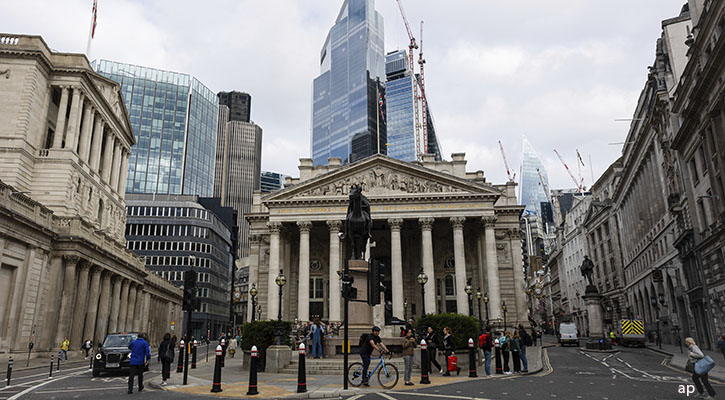
This is an updated version of our 2020 article 'Do Currencies Matter for Fund Investors?'.
Something’s been made abundantly clear in the last two weeks – currencies matter a lot, and can play a significant role in your investment returns. Yet most investors don’t consciously factor currencies into their decision about what to buy and sell. When you invest in shares, ETFs, investment trusts and funds you may be making a bet on currency without even realising.
UK residents have since the recent mini-Budget announcement seen sterling plummet, lurching towards parity before recovering. This is also just the sell-off for the pound – the currency has been weak since the Brexit vote, which is particularly noticeable when we go abroad on holiday. The pound is at a 37-year low against the dollar, for example.
As we’ve seen, the strength of sterling affects more than your holiday spending money, but for investors, a soft pound can sometimes be positive for your returns.
Already Invested? Keep Calm
Weak sterling does actually help some UK investors, explains Morningstar analyst Samuel Meakin. If the companies you invest in report their earnings in stronger currencies like the dollar, euro or yen.
If these companies’ shares are rising too, the currency and the appreciation provide a double benefit. “Essentially you’re owning US dollars, and if the dollar is going up, you’re making money on that,” says Meakin.
So for example, if you bought Exxon Mobil (XOM) shares the start of one year, you are exchanging pounds for dollars. At the end of the year, assuming the share price has risen and the pound has weakened over the period, your investment is worth more because of the currency you've bought the shares in has appreciated.
Exxon shares are up 37% this year in dollar terms, but the dollar has gained 18% against the pound. So you've had a double uplift, a capital gain and a currency gain.
What about UK Investments?
The image is slightly different for those investing in the UK. As Morningstar analyst Jack Fletcher-Price calculated, investors would have been better off just buying US dollars outright than investing in the highest-rated UK equity income funds, if the investment was made ahead of the “stability with Cameron/chaos with Ed Miliband” General Election in 2015.
If you invested £10,000 into one of the most popular income funds in the Spring of 2015, your investments would still be up. Artemis Income is the best performer over the period, with a cumulative return of 35.31% and an annualised return of 4.16%. The investment would have grown to £13,531.
But as mentioned beore, the US dollar has been strong, and especially so this year, against a basket of currencies. If you just bought the currency with £10,000 instead of investing, you would have been left with £14,295.
Comparing Share Classes
Life isn't so straightforward with UK funds that invest overseas, as you are often faced with a range of currency options, including dollar, euro and sometimes yen share classes for popular funds. For the sake of simplicity, most UK investors would choose the GBP version. But the version you choose does affect your returns.
In a year of a global drop in share prices, a weak sterling has dampened returns. If we look at some global growth funds, which have admittedly struggled, the returns are pretty significant. The GBP iteration of Baillie Gifford Worldwide Long Term Global Growth Fund, for example, is down 32.84%, while the USD version is down 46.30%.
We see the same for BNY Mellon’s Long-Term Global Equities fund and Fundsmith Equity – the difference in returns is in double digits.
If we look at energy funds, a largely successful investment category in 2022, we see a similar pattern on the upside. If you invested in BGF World Energy’s D4 share class at the start of the year, your returns would look now like this: a 20.49% increase for USD investors and a 48.20% increase for GBP investors.
Investors in RobecoSam Smart Energy X, on the other hand, would be down 13.02% if you had bought the sterling iteration and down 29.15% in USD.
Year-on-Year Differences
This fund data only reveals the differences this year though. When my colleague James Gard last looked at this, in 2020, he took a longer-term view, looking at the year-on-year changes from 2016. He saw that in some years, an investor holding the sterling share class fared slightly better than those holding the domestic currency version (whether dollar, euro and yen) and other years the opposite has been true.
In 2017, the pound strengthened against the dollar but weakened against the euro. Sterling investors in Merian North American Equity then outpaced dollar investors by about a percentage point. But, for investors in JOHCM Continental European, those choosing EUR over GBP won out.
While this isn't a comprehensive survey, it's notable that in years when the pound was stronger, the GBP share class outperformed – and vice versa when the pound was weaker.
Caveat: Monthly Versus Yearly Investing
For investors buying fund units in an ISA monthly savings plan, their experience of currency fluctuations will be different to people who buy via lump sums. For example, if you'd put your entire ISA allowance of £20,000 in one fund in April this year, your returns will not be the same as someone filling up their allowance with a monthly investment of £1,666.66. Currencies rarely move in predictable patterns but the one-year chart of GBP to USD is unambiguous: a year ago the exchange rate was $1.36 and is now $1.12. So if you are buying fund units in dollars with pounds, then you would have bought buy fewer and fewer units over the year.
Pound cost averaging is a common concept in investing: as a regular investor you would want the asset you're buying to fall because you will pick up more shares or fund units. My colleague Tom Lauricella has looked at this issue in detail in his analysis of whether drip feeding or lump sums produce better returns.
Hedged or Unhedged?
What if you want to remove the currency risk altogether? Funds usually offer a “hedged” version of each share class which aims to neutralise as much as possible the effects of currency movements on returns. This option often appeals to professional investors who have a view on where a currency is going, and are looking to balance out the portfolio.
But hedging is never perfect, and hedged share classes can often be more expensive. Hedges are based on currency futures (a type of derivative) and, like any other trading strategy, the manager may get the trade right one year and wrong the next.
Currencies, like stock markets, have a habit of doing unexpected things. The hedged Lindsell Train Japan fund would have returned 1.7% in 2016, for example, while an investment in the unhedged version would have grown 26% that year as sterling slumped. The following year, however, the hedged version returned almost 34%, while the unhedged share class returned 24.74%.
Can You Beat the Market?
So where does that leave the average investor who doesn't have an opinion on whether which way the pound is going to go? Fletcher-Price says: “For investors who wish to manage their currency exposure, hedged share classes can offer a relatively simple solution to do so. However, similar to individual security selection and asset allocation, currency risk can have a large bearing on performance and should be properly researched. For a UK investor not wishing to actively manage their currency risk, an unhedged GBP share class is the most popular choice.
“A reversal at some point of sterling's weakness will act as a drag to sterling investors on a global basis, but trying to time these things is exceedingly difficult,” he concludes.




























